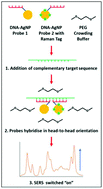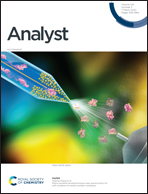DNA detection by SERS: hybridisation parameters and the potential for asymmetric PCR†
Abstract
The use of surface enhanced Raman scattering (SERS) for the detection of DNA has significant potential in terms of sensitivity, multiplex target detection and robust signal detection from nanoparticles. Current methods are usually performed with short chain DNA fragments or require additional separation steps for detection of longer chain fragments. We present an integrated method for the rapid and sensitive detection of extended (≥100-base) nucleic acids with reduced preparation and sample separation steps. Key to this is the DNA sequence-specific assembly of silver nanoparticles labelled with a Raman tag to provide an enhanced signal from the tag and hence molecular recognition of the target DNA. DNA probe orientation and hybridisation procedures are critical for the success of this assay. Effective detection of extended nucleic acids was achieved with head-to-head probes and by adding polyethylene glycol 10 000 (PEG 10 000) to the hybridisation buffer. This gave a 34-fold discriminatory enhancement factor when applied to a synthetic target. A structured approach toward maximising hybridisation procedures and SERS response is described, followed by an initial demonstration of SERS detection of single-stranded DNA target amplified by asymmetric PCR which was used without further separation. This has implications for future developments in using SERS for DNA detection due to the new-found ability to integrate SERS with asymmetric PCR.



 Please wait while we load your content...
Please wait while we load your content...